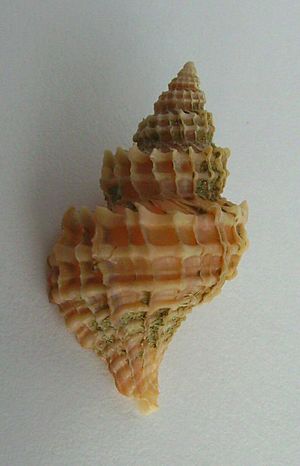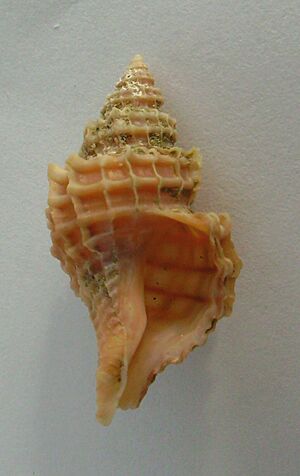Zeatrophon ambiguus facts for kids
Quick facts for kids Zeatrophon ambiguus |
|
|---|---|
 |
|
| A shell of Zeatrophon ambiguus (female) | |
| Scientific classification | |
| Kingdom: | |
| Phylum: | |
| Class: | |
| (unranked): |
clade Caenogastropoda
clade Hypsogastropoda clade Neogastropoda |
| Superfamily: |
Muricoidea
|
| Family: |
Muricidae
|
| Subfamily: |
Pagodulinae
|
| Genus: |
Zeatrophon
|
| Species: |
Z. ambiguus
|
| Binomial name | |
| Zeatrophon ambiguus (Philippi, 1844)
|
|
| Synonyms | |
|
|
Zeatrophon ambiguus, also known as the large trophon, is a fascinating type of large sea snail. It is a marine (ocean-dwelling) gastropod mollusc. This snail belongs to the family Muricidae, which are often called rock snails or murex snails.
Contents
What is Zeatrophon ambiguus?
Zeatrophon ambiguus is a species of snail that lives in the ocean. It is known for its relatively large size compared to many other snails. This snail is a predator, meaning it hunts and eats other animals.
Where Does This Snail Live?
As a marine animal, Zeatrophon ambiguus lives in the ocean. It is found in the waters around New Zealand. These snails prefer certain habitats on the seafloor.
What Does a Large Trophon Look Like?
The large trophon has a distinctive shell. The shell is usually strong and spiral-shaped. Its appearance helps protect the soft body of the snail inside. The color and texture of the shell can vary.
Shell Features and Appearance
The shell of Zeatrophon ambiguus has specific features. It often has ridges or spirals that make it unique. The opening of the shell, called the aperture, is where the snail's body emerges. The shell's shape helps it move and stay safe.
How Does the Large Trophon Live?
Zeatrophon ambiguus is a predatory snail. This means it actively hunts for its food. Snails in the Muricidae family are known for their hunting skills. They use special tools to get to their prey.
What Do These Snails Eat?
Large trophons typically feed on other marine creatures. They might eat other smaller molluscs or bivalves. They use a special radula (a ribbon-like structure with teeth) to drill into the shells of their prey.
How Do They Hunt?
The snail uses its radula to create a small hole in the shell of its prey. Once the hole is made, it can then consume the soft body inside. This method of feeding is common among many predatory sea snails.
Classification of Zeatrophon ambiguus
Understanding how animals are grouped helps us learn about them. Zeatrophon ambiguus belongs to several scientific groups. These groups show its relationship to other living things.
Animal Kingdom and Phylum
- Kingdom: Animalia (All animals)
- Phylum: Mollusca (Molluscs, which include snails, clams, and octopuses)
Class and Family
- Class: Gastropoda (Gastropods, which are snails and slugs)
- Family: Muricidae (Rock snails or murex snails, known for their strong shells)
Genus and Species
- Genus: Zeatrophon
- Species: Z. ambiguus
This classification helps scientists organize and study all life on Earth.
History and Discovery
The large trophon was first described by a scientist named Rodolfo Amando Philippi. He officially named this species in 1844. This was an important step in understanding marine life.
Other Names for the Snail
Over time, this snail has been given a few different scientific names. These are called synonyms. Scientists sometimes change names as they learn more about a species. Some old names include Fusus ambiguus and Xymene ambiguus.
Images for kids




